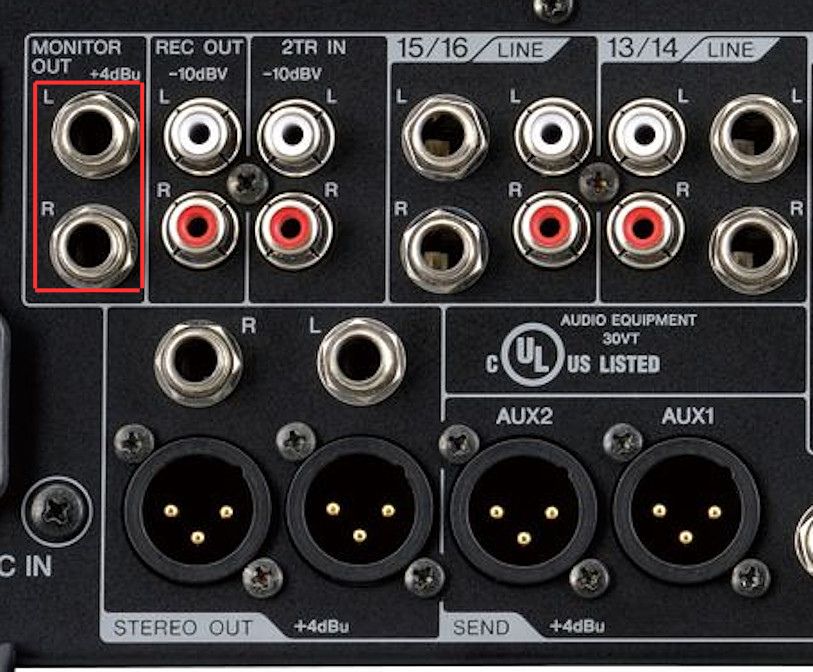
One of the output ports that can be found in both mixing consoles and amplifiers is the Monitor Out port. With mixing consoles and amplifiers performing entirely different functions, does that mean the functionality of their Monitor Out ports and the type of signal they carry vary as well? I will address these and more in this article so read till the end.
Functionally, there is no difference between the monitor out found on mixers and that found on amps. These monitor outs are line-level audio outputs that primarily function as an output for monitoring a live or recording mix.
Table of Contents
What Is Monitor Output?
A Monitor Out is usually found on mixers, audio interfaces, amplifiers, preamps, and most pro-audio hardware. In most of these audio devices, this type of output is always separated from the other outputs on the hardware.
A Monitor Out on any hardware is a line-level audio output designed for listening to the main mix or individual channels or sources routed through the audio hardware. This output is made to allow a person to hear what is happening elsewhere in the system without using main outputs to do so.
Using Monitor Out is a great way to hear what is happening on stage, in the recording booth, or in audio broadcasts without affecting the audio sent through the main mix or recording outputs.
This is an important feature for every audio or mixing engineer since the Monitor Output allows them to monitor the audio without having to waste any primary outputs. In addition to all these, Monitor Outputs can be used to isolate specific channels without altering the main audio mix.
A Monitor Output is usually an unbalanced output at line-level. This means it usually requires some form of an amplifier to be used well. They can be made for stereo output for studio monitoring, or they can be equipped with a small preamp for headphone monitoring.
This output port is among the most useful outputs for any audio engineer in any capacity since it allows the engineer to make changes to the audio mix on the fly and also enables them to hear what the rest of the crew or band is hearing.
How to Use a Monitor Output
As I have mentioned throughout this article, the primary function of monitor output is for monitoring stage mixes by engineers. Although this is its primary function, a monitor out has a lot more to offer sound and mixing engineers as well as musicians in general.
The truth is, apart from being used for monitoring main mixes by sound engineers, a monitor output can be used for two other purposes. Thus there are two additional ways you can use a Monitor Output.
A monitor out can also be used as a secondary output or a monitor mix for musicians, and for sending audio to an effects loop.
What this means is, a monitor out is not meant only for monitoring stage mixes. Let’s look deeper into each use to understand the full potential of a Monitor Output and how it can be used effectively.
How to Use your Monitor Output: Secondary Output/Monitor Mix for Musicians
Monitor Out can also be used as a secondary output or monitor mix for a number of applications. It can be used to send audio to an external speaker in a different location, such as a recording room, or to monitors on stage.
The good thing is, as long as your speakers are powered, a Monitor Out will work very well for these purposes as it is easy to deploy for this functionality without altering the rest of the setup.
It is important for performing or recording musicians to hear themselves and their bandmates clearly when performing with a good mix of instruments and vocals. That can be hard to achieve when the only sound musicians have to work with is fed from the main mix.
Fortunately, this is possible via a Monitor Output. A Monitor Out is an excellent output for this, as it does not limit any other functions of the audio device, nor does it make changes to the FOH mix when the monitor mix is altered.
Therefore, aside from being used as a monitor for a recording or mixing engineer, the Monitor Out on an audio device can be used to send a monitor mix directly to musicians on stage.
Just as I mentioned in my previous article titled “Are Stage Monitors Necessary?”, a monitor out can be used to emulate what is heard from the Front of the House. This ensures that musicians perform at their best by staying in tune and on time with the song being sung.
Apart from all these, a monitor out can simply be used to send audio to additional speakers for audio playback as well.
How to Use your Monitor Output: Sending Audio to an Effects Processor
Finally, a Monitor Out can be used to send audio to an effects processor or into an effects loop to be sent back into the main signal chain. This enables you to EQ the effects and routes them where necessary.
An effects processor can be routed using a monitor output to give engineers more control of their effects signal path. This is an excellent use for Monitor Out, as it can be used completely independently from the rest of the audio output since it is not affected by main mix modifications.
Sending audio to an effects processor using your monitor output effectively means, you are using your monitor output as an AUX or EFX send.
Is a Monitor Out the same as a Main Out?
Most devices that come with a Main Out port usually have Monitor Out ports as well. Thus, Main Out and Monitor Out ports are commonly seen on the same devices.
Apart from being found on the same devices, if you listen to audio from both of these sends, they usually sound the same. This has led many to wonder if the Main Out and the Monitor Out are the same.
The fact is, a main out and a monitor out are not the same. A main out is designed to be the primary source of audio from mixing consoles whiles monitor outs provide sound engineers and mixing professionals with a pathway to listen to the audio signal through secondary speakers without disturbing the main mix.
A Main Out in any device is a speaker-level output that serves as the primary audio output from the device. A typical example is the Main Out found on mixing consoles. The Main Out in this audio equipment is a set of balanced stereo outputs that send a strong signal that is affected by signal modifications and processing.
The Monitor Out, by contrast, is not usually a balanced output. Additionally, it possesses specific functionality such as individual channel routing to listen to one channel at a time without muting anything.
Finally, unlike the signal from a main out that is an amplified speaker-level output, the audio signal from a monitor out usually requires amplification as it is sent at line level.
In summary, a Main Out is the primary audio source used to project audio to the Front of House speaker system whiles a Monitor Out is used by engineers and mixers to listen to the audio signal from secondary speakers without disturbing the main mix.
If you want to read more about main outputs, you should read this article titled “Sub Out vs Main Out“.
Conclusion
Monitor Out is a common output on mixing consoles, external amplifiers, and many other audio devices. This port is an important output for live audio and recording applications. It is the multi-functional output that can help transform your sound significantly.
Therefore, it is important that everyone who works with audio equipment learns to fully understand the use of the Monitor Out. Take the time to explore and experiment with the various uses of Monitor Out on your audio device to find its limitations and its strengths. Using this output well can completely change your audio mixing experience.

Hello, I’m Elijah. A writer on Geek Musician, based in Ghana-West Africa. I am a writer with a passion for research and reading. I usually spend my free time playing chess or watching movies. For more info, check out my about me page. Or read more of my articles here.
